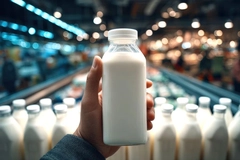Household packaging: Crafting material innovations to meet regional demands

04 Sep 2024 --- Leading companies in the household goods industry are making progress toward more sustainable packaging, meeting consumer demand for eco-friendly solutions and preparing for a future where environmental responsibility and economic success go hand in hand. As the companies continue to innovate and adapt, they are paving new trends in the packaging industry.
Carsten Bertram, head of packaging sustainability at Henkel Consumer Brands, tells Packaging Insights: “Household packaging designs are currently characterized in particular by sustainability aspects, which is not a trend, but a long-term development.”
“Changes in packaging are therefore mainly related to a larger share of Post Consumer Recycled (PCR) material, the change to recyclable packaging formats and a switch from plastic to recyclable paper packaging where technically possible and environmentally beneficial. Also, refillable and reusable packaging plays a key role, with more and more offers coming to the market.”
This shift toward sustainable materials is also echoed by Umberto Reggiani, sales director at Clevertech Group, who highlights the increasing use of biodegradable, compostable and recycled materials.
“Companies are investing in materials that not only degrade easily in the environment but can also be composted, reducing environmental impact. This trend is supported by both regulatory pressure and consumer demand for more eco-friendly solutions.”
 Carsten Bertram, head of packaging sustainability at Henkel Consumer Brands.“Recycled materials are gaining ground in packaging, with a particular focus on materials sourced from closed-loop recycling chains, such as plastic recovered from oceans.”
Carsten Bertram, head of packaging sustainability at Henkel Consumer Brands.“Recycled materials are gaining ground in packaging, with a particular focus on materials sourced from closed-loop recycling chains, such as plastic recovered from oceans.”
Meanwhile, Thea Corwin Bristøl, chief marketing and communications officer at Elopak points out that consumer demand is driving a move away from single-use plastic packaging.
“Research commissioned by Elopak in 2023 showed that 90% of shoppers in the UK and Germany say reducing plastic is important to them, while 75% want to reduce their personal carbon footprint. As a result, consumers are often willing to try novel packaging formats that are a better fit with their sustainability principles.”
Innovations in materials and formats
The drive toward sustainability has spurred innovation in packaging materials and formats. Henkel, for example, has made strides in incorporating recycled materials into its packaging. Bertram points out that they are seeing a move away from transparent PP bottles.
“At Henkel, we have changed the material of our major laundry detergent bottles in Europe from PP to HDPE, as it has enabled us to use a 50% recycled material,” says Bertram.
Clevertech is also exploring new packaging formats that cater to the evolving needs of modern consumers. Reggiani highlights the rise of convenience-oriented packaging. “With the demographic shift toward a higher number of single-person households, there is a growing demand for convenient and user-friendly packaging. The Sellable Unit Dose process addresses this need by offering single doses for washing products, reducing waste and improving usability.”
“Convenience is also reflected in resealable products, or packages that can be opened and closed, allowing multiple uses without losing the product’s freshness or integrity. This type of packaging meets the needs of consumers seeking practicality.” Clevertech is follwing the trend in the industry, innovating in materials, formats and processes to meet the evolving needs of consumers.
Clevertech is follwing the trend in the industry, innovating in materials, formats and processes to meet the evolving needs of consumers.
Elopak, on the other hand, is focusing on the potential of cartons as a sustainable alternative to plastic bottles.
“After Orkla Home and Personal Care transitioned some of its home and personal care products into Elopak cartons, they noted a 90% reduction in plastic, as well as 80% more efficient filling of boxes and 94% fewer truck trips due to the more efficient design of cartons,” Bristøl shares.
Regional variations and consumer awareness
While sustainability is a global priority, regional variations and market dynamics influence how companies approach packaging.
“The market for household detergents exhibits different dynamics depending on geographical areas, influenced by local preferences, cultural habits, and socio-economic changes,” says Reggiani.
“In countries like China and India, household detergents have traditionally been in the form of powders or solid detergents. However, there is a growing shift toward liquid detergents. In India, for example, the increased use of bottled gas for cooking has reduced the availability of ashes, which were used by rural populations to clean dishes and other items. This change has boosted the demand for industrial detergents, which is also driven by demographic growth and the increase in household purchasing power.”
In contrast, Europe and the US are seeing a trend toward more ecological and compact packaging solutions.
“In Europe and the US, the household detergent market is dominated by liquid products for more than 80%. In Europe, there is a trend toward sustainable and ultra-concentrated solutions, known as Single Use Dose,” he continues.
“These solutions are replacing traditional HDPE plastic containers of 1-2 liters (Europe) and 3 Liters (US) with cardboard packaging containing single liquid doses. These packages are more compact but offer several washes equivalent to traditional 2-liter formats, thus contributing to reducing environmental impact.”
Apart from changing the bottle bodies of liquid detergents in Europe to 50% recycled material, Henkel has reduced the amount of plastic used in several products in developing countries.
“In South Korea, we have introduced a new monomaterial pump combined with a 100% recycled PET bottle for our Pril brand,” Bertram highlights.
 Thea Corwin Bristøl, Elopak chief marketing and communications officer.“In Mexico, we have entered into a partnership with a local recycling company that produces HDPE recyclate from household packaging waste. This partnership has enabled us to convert a range of detergent bottles, including Persil, to 50% recyclate.”
Thea Corwin Bristøl, Elopak chief marketing and communications officer.“In Mexico, we have entered into a partnership with a local recycling company that produces HDPE recyclate from household packaging waste. This partnership has enabled us to convert a range of detergent bottles, including Persil, to 50% recyclate.”
Reggiani also notes that the COVID-19 pandemic, in particular, has heightened consumer awareness of hygiene and environmental issues.
“In the immediate aftermath of the pandemic, there was a strong demand for quality in household products. However, we are now observing a return to the use of co-packer products due to ongoing conflicts and economic hardships, which push consumers to opt for more economical solutions.”
Opportunities in the future
The shift to sustainable packaging presents new opportunities for companies. At Elopak, the opportunity lies in the use of cartons as “pre-fill” packaging for household goods.
Last year, a study from Elopak revealed strong consumer interest in the UK and Germany for carton refill packaging, with 61% of respondents willing to purchase fabric softener and 59% floor cleaner in this format.
“This style of packaging still reduces plastic consumption and emissions and is far more convenient than having to bring your container to the store. It also allows consumers to buy in bulk more easily,” says Bristøl.
“This allows consumers to purchase pre-filled cartons of, say, hand soap to then fill up a primary container at home which might have added functionality like a pump dispenser.”
Bertram says that to accelerate the transition to recyclable packaging, Henkel recently invested in an NIR scanner for its R&D packaging lab at the company’s headquarters in Düsseldorf to “allow in-house NIR sorting tests in the early development stages.” Multiple Life Cycle Analysis studies have shown that cartons made from paperboard are associated with fewer emissions than plastic bottles.
Multiple Life Cycle Analysis studies have shown that cartons made from paperboard are associated with fewer emissions than plastic bottles.
“Each of our new packaging designs needs to contribute to a reduction of CO2 emissions and to an increase of circularity,” he asserts.
Clevertech identifies new opportunities with the thriving e-commerce industry, which requires packaging companies to be agile and flexible to support their customers and stay competitive.
“There is a growing demand from e-commerce platforms, which are becoming an increasingly important distribution channel for household products. This shift is adding another layer of complexity to packaging requirements as companies strive to meet the needs of both traditional in-store distribution and the expanding e-commerce sector,” says Reggiani.
“Household packaging is in a phase of rapid evolution, with increasing emphasis on sustainability, convenience and efficiency. Companies must be ready to innovate and adapt to meet the new demands of the market and consumers.”
By Sichong Wang











